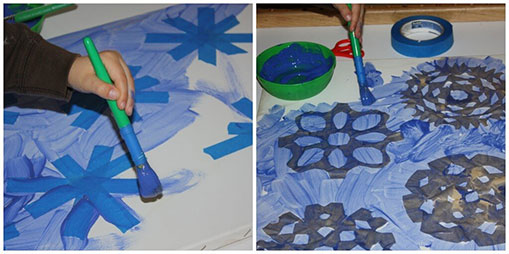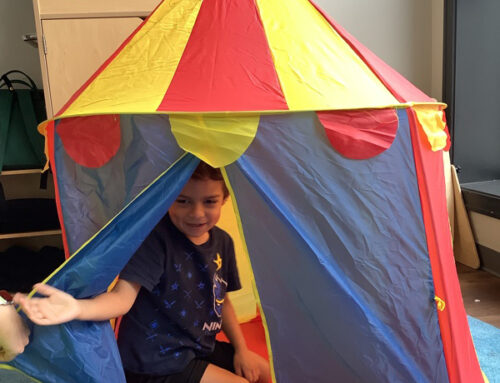Creating a craft with your child is a great way to target a variety of skills and end up with an adorable memento! Included are some examples of activities that children of all skill levels can be successful in given the right support. Paint snowflakes by creating a template with tape or coffee filters, allowing kids with all types of abilities to successfully participate.

Areas of Development:
- Communication: Narrate what your child is making. You can label the colors and textures of the supplies paired with high effect to promote engagement. As with worksheets, you can incorporate action and directional words into a narration.
- Fine Motor: While painting, focus on your child’s grasp pattern and use of force. A larger paintbrush handle is easier to grasp and is a great place to start. The use of brushes with a smaller (length and width) handle increases accuracy while increasing precision required to maintain grasp pattern. Presenting your child with a few different options and allowing them to choose helps promote problem-solving and decreases the pressure around the task, making it more enjoyable for all!
- Gross Motor: While engaged in crafts, focus on your child’s posture and positioning while seated at the table. If expanding gross motor development is a priority, you can place items at different places around the room, encouraging your child to scan the room to locate needed tools. They can walk, run, hop, or crawl to gather all of the items needed for the craft, providing some movement prior to engagement in a seated task.
- Social-Emotional: Incorporate turn-taking and cooperative play, where you work with your child to create a masterpiece! Engagement in arts and crafts can be a great way to build frustration tolerance, supporting self-efficacy, and pride in accomplishments even when mistakes are made. Modeling how to solve the problem or how to react when things don’t turn out the way you expected can help build your child’s coping strategies.
- Cognition: Crafts are great multi-step activities that require a specific order to be successful, such as gathering supplies, prepping the activity, and cleaning up afterward. Crafts are a great way to target sequencing, following directions, and maintaining attention to the task at hand.
Upgrade: Make paper snowflakes! Use coffee filters to create a unique pattern, folding the filter in half three times. You can draw patterns on for your child to follow or let them freestyle! Use these as your template when painting, though keep in mind you may need to help your child decrease the amount of paint used, as it can seep under the filter.
Downgrade: Prep the activity for your child, pre-placing the tape on the paper. Your child will be able to make a beautiful craft with a single step of the painting. Encourage your child to help with clean up, using hand over hand assistance to wash out the paintbrush.

Blue Bird Day—the first therapeutic preschool and kindergarten program in the nation—fosters socialization, sensory regulation, and pre-academic learning in children ages 2-7 years. Our compassionate therapists practice a relationship-based and family-centered approach, provide parent training, and collaborate on goals and individualized intensive treatment plans for your child.
We believe in a collaborative and multi-disciplinary team approach to therapy. A team of occupational therapists, speech-language pathologists, dietitians, developmental therapists, behavioral therapists, physical therapists, and therapeutic assistants are created for each child to ensure child and family are fully supported and the best possible results are achieved.
Options for individualized, group and virtual therapy sessions are available as well.
Want to learn more or you have a specific question? Feel free to connect with us here!



